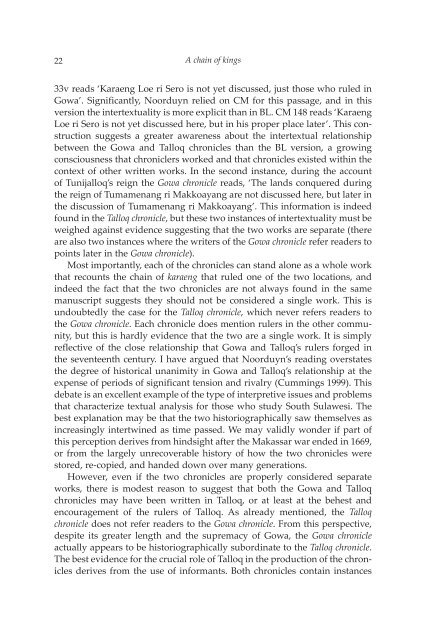A CHAIN OF KINGS - Books and Journals
A CHAIN OF KINGS - Books and Journals
A CHAIN OF KINGS - Books and Journals
Create successful ePaper yourself
Turn your PDF publications into a flip-book with our unique Google optimized e-Paper software.
22<br />
A chain of kings<br />
33v reads ‘Karaeng Loe ri Sero is not yet discussed, just those who ruled in<br />
Gowa’. Significantly, Noorduyn relied on CM for this passage, <strong>and</strong> in this<br />
version the intertextuality is more explicit than in BL. CM 148 reads ‘Karaeng<br />
Loe ri Sero is not yet discussed here, but in his proper place later’. This construction<br />
suggests a greater awareness about the intertextual relationship<br />
between the Gowa <strong>and</strong> Talloq chronicles than the BL version, a growing<br />
consciousness that chroniclers worked <strong>and</strong> that chronicles existed within the<br />
context of other written works. In the second instance, during the account<br />
of Tunijalloq’s reign the Gowa chronicle reads, ‘The l<strong>and</strong>s conquered during<br />
the reign of Tumamenang ri Makkoayang are not discussed here, but later in<br />
the discussion of Tumamenang ri Makkoayang’. This information is indeed<br />
found in the Talloq chronicle, but these two instances of intertextuality must be<br />
weighed against evidence suggesting that the two works are separate (there<br />
are also two instances where the writers of the Gowa chronicle refer readers to<br />
points later in the Gowa chronicle).<br />
Most importantly, each of the chronicles can st<strong>and</strong> alone as a whole work<br />
that recounts the chain of karaeng that ruled one of the two locations, <strong>and</strong><br />
indeed the fact that the two chronicles are not always found in the same<br />
manuscript suggests they should not be considered a single work. This is<br />
undoubtedly the case for the Talloq chronicle, which never refers readers to<br />
the Gowa chronicle. Each chronicle does mention rulers in the other community,<br />
but this is hardly evidence that the two are a single work. It is simply<br />
reflective of the close relationship that Gowa <strong>and</strong> Talloq’s rulers forged in<br />
the seventeenth century. I have argued that Noorduyn’s reading overstates<br />
the degree of historical unanimity in Gowa <strong>and</strong> Talloq’s relationship at the<br />
expense of periods of significant tension <strong>and</strong> rivalry (Cummings 1999). This<br />
debate is an excellent example of the type of interpretive issues <strong>and</strong> problems<br />
that characterize textual analysis for those who study South Sulawesi. The<br />
best explanation may be that the two historiographically saw themselves as<br />
increasingly intertwined as time passed. We may validly wonder if part of<br />
this perception derives from hindsight after the Makassar war ended in 1669,<br />
or from the largely unrecoverable history of how the two chronicles were<br />
stored, re-copied, <strong>and</strong> h<strong>and</strong>ed down over many generations.<br />
However, even if the two chronicles are properly considered separate<br />
works, there is modest reason to suggest that both the Gowa <strong>and</strong> Talloq<br />
chronicles may have been written in Talloq, or at least at the behest <strong>and</strong><br />
encouragement of the rulers of Talloq. As already mentioned, the Talloq<br />
chronicle does not refer readers to the Gowa chronicle. From this perspective,<br />
despite its greater length <strong>and</strong> the supremacy of Gowa, the Gowa chronicle<br />
actually appears to be historiographically subordinate to the Talloq chronicle.<br />
The best evidence for the crucial role of Talloq in the production of the chronicles<br />
derives from the use of informants. Both chronicles contain instances









![Am HaSefer [Volk des Buches] - Books and Journals](https://img.yumpu.com/20648352/1/174x260/am-hasefer-volk-des-buches-books-and-journals.jpg?quality=85)







